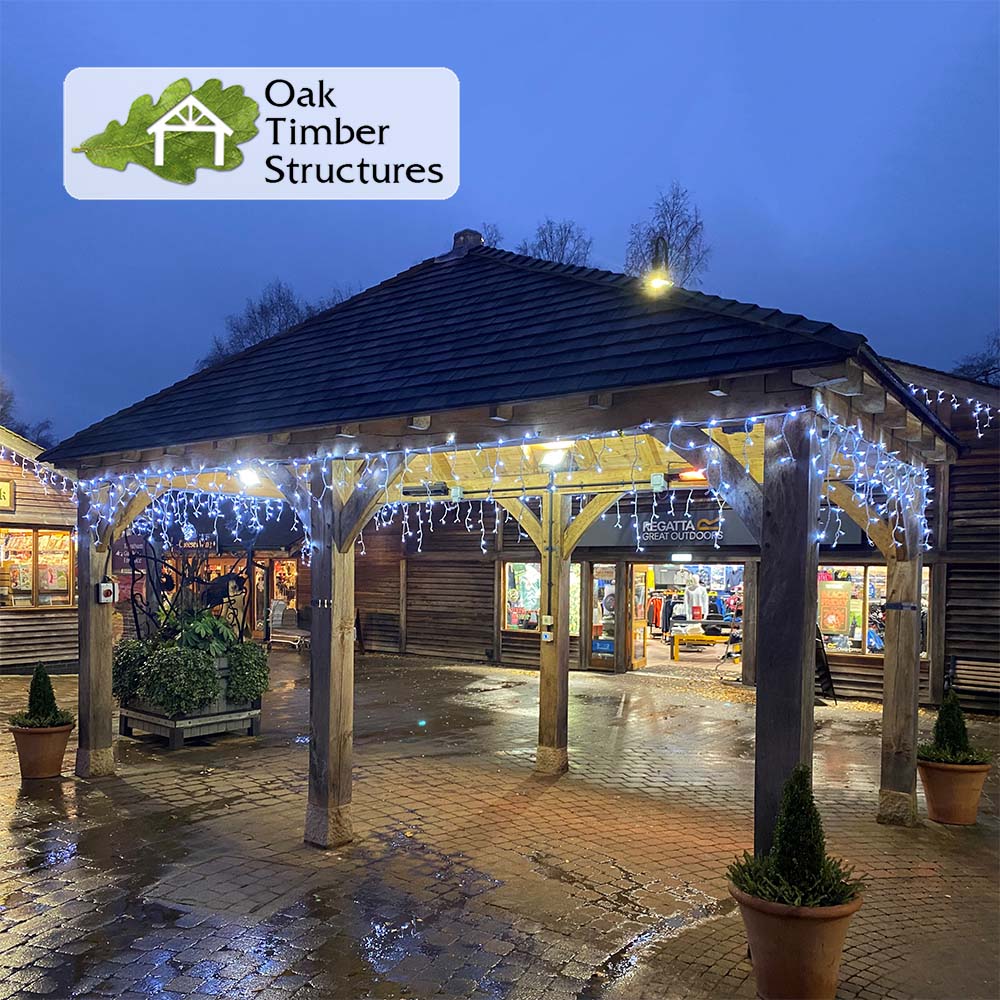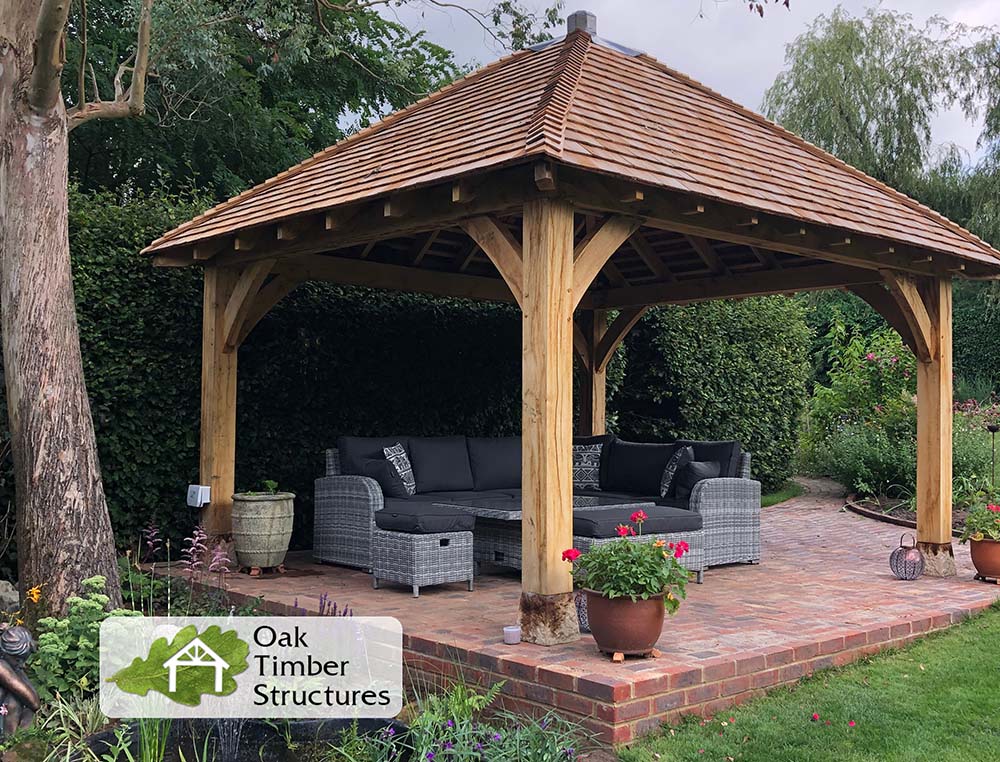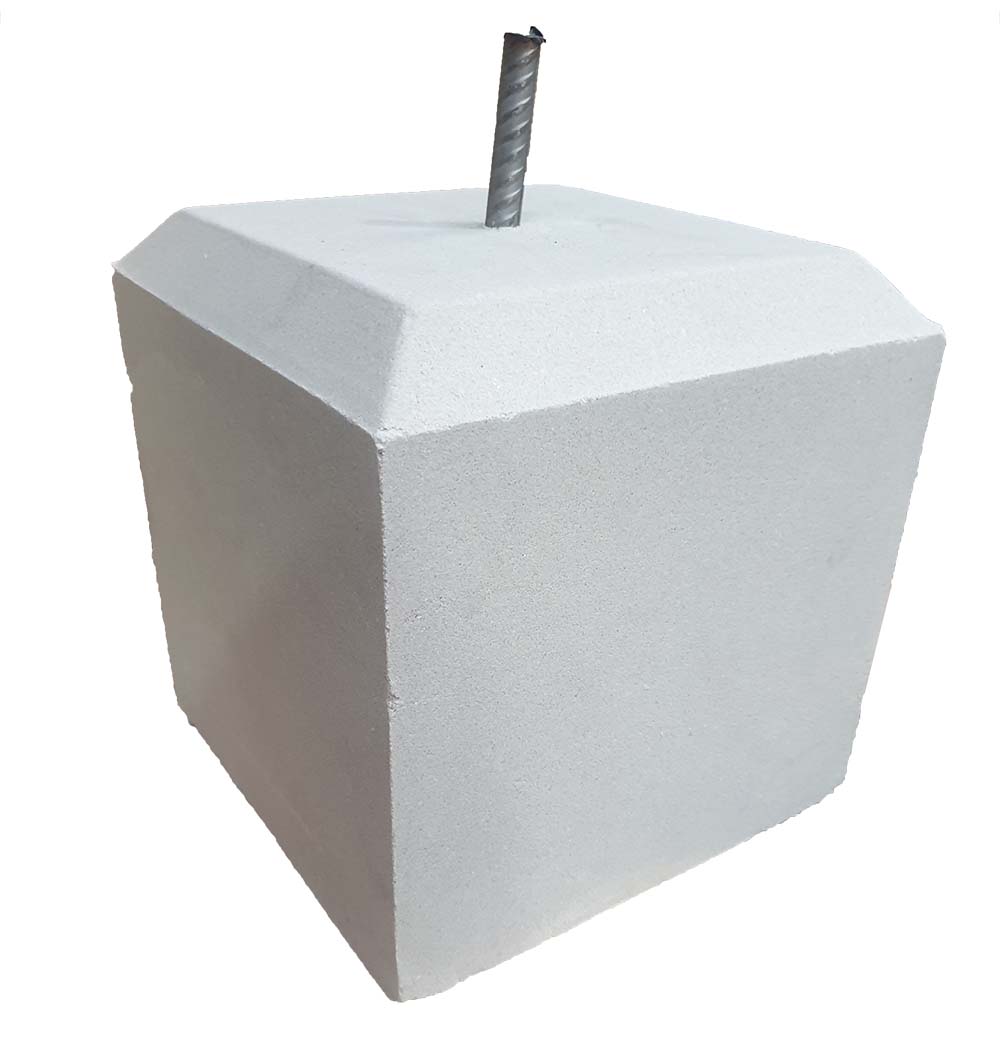News: Weatherproofing an Oak Structure: Do You Really Need It?
21/03/2022
Weatherproofing an oak structure is a multi-faceted question.
There’s no one size fits all approach because how you tackle weatherproofing, will in large depend on the structure itself.
For instance, an oak garage will need more attention than an oak gazebo.
Confused? You needn’t worry, as you'll find out in this article, weatherproofing an oak structure can be easy with the right knowledge.
Do You Need To Weatherproof Oak?
Oak is a hardwood with natural resistance to weathering. It's up to five times more durable than any softwood. On account of this, if you decide to make a structure from oak… You're off to a great start.
But, oak isn't immune from weathering. One standout effect of weathering is the silvering sensation. UV rays from the sun change the colour of oak. Some of our customers have reported their structures silvering after a year or two in situ, some even less than a year.
As luck has it, this gives oak a traditional and rustic demeanour, something most oak enthusiasts want. Alongside all of the characterful splits and cracks typical of aged oak.
Yet, if you want to keep that fresh sawn oak look, you can treat oak with oil, in particular, Osmo UV-Protection Oil. After applying a base-coat, a few coats of this UV protection oil will slow the natural silvering transformation by up to 12 times more.
We expand on this in our information booklet where we also mention Osmo 4001, a base coat to be applied before the UV protector.
Let's not forget, we're in Britain, so less safeguarding against the sun. What about rain?
At Oak Timber Structures, we make all our products from European oak. Why does the location matter? By sourcing wood in Europe, it’s acclimatised to a temperate environment. So when faced with a similar climate, there’s a less dramatic change to oak.

So consider the origin of your fresh sawn oak and where you’ll assemble the architecture.
Even on those rainy UK days, waterproofing with an oil solution isn’t a necessity. But, it does help.
You’ll find many oils claiming to protect oak. Many of our customers have seen great results with Osmo 4001 to protect their structures from potential issues such as rot, mildew, blue stain while also reducing moisture movement.
This approach applies to any upright oak structure. Whether a small oak garden swing or a gigantic solid oak gazebo, it's a top waterproofer for oak.
If you want further information on maintaining an oak structure, check out this article.
Now we're done with the basics. Let's get to the nitty-gritty.
The Ultimate Secret To Weatherproofing an Oak Gazebo
On The Roof
For the roofing of a gazebo, there’s a simple method to make the gaps watertight.
Tiles and shingles alone, by their very nature, run rain away from a structure. What's more, we offer treated cedar shingles for added protection against weathering.
Untreated cedar shingles have a lifespan of around 20+ years whereas treated cedar shingles last 25+.
Although you'll gain five years lifespan, treated cedar shingles are darker. So there are pros and cons. Weighing it up, it's typical for customers to forego the treatment for a more traditional and natural view.
Now for the specifics, if you opt for a gazebo with a hipped roof, you'll have a lantern that protrudes from the top. You'll need to seal this to prevent water from leaking between shingles and the lantern.
Aluminium flashing is the most common method to cover the top and sides of the lantern.
What is aluminium flashing?
Aluminium flashing is a shapeable sheet of metal. By sculpting all around the lantern, it acts as a barrier to protect areas where moisture would otherwise pass through.
Having covered the top and sides, you can shape it towards the shingles or tiles routing rainwater away from the structure. Likewise, some customers fashion a skirt around the lantern then use silicone to seal any gaps.
In the below image, you’ll see well-fitted aluminium flashing around the lantern.

WR Base Coat. This'll prevent moisture from entering the boarding thus minimising shrinkage and swelling.
Ensure you treat all four faces of the board for before affixing to the structure to completely seal the timber.
Regardless of the treatment used, when treating boarding you must treat all four faces of the board, if you leave the sides untreated the moisture will still be able to get in and will get trapped behind the treatment.
Building A Solid Foundation
So that's the top sorted. But what about the bottom? For solid oak structures like gazebos and pergolas, you can prevent oak posts from coming into contact with standing water by raising them.
Why's standing water more detrimental than rainwater?
Rainwater runs down oak posts and off the structure. Likewise, shingles are designed to route water away from the mainframe. Whereas the constant contact of standing water will penetrate up through the oak.
First, oak structures should have stable and flat ground to rest on. During heavy rain, grass becomes unstable and the weight of a gazebo or pergola can cause sinkage.
That's why patios, paving, decking, slabs and concrete pads are the most reliable foundation to place an oak structure.
Not only increasing stability but raising the oak structure keeps posts dry, thus increasing their lifespan.
If you have an existing base, make sure standing water doesn't gather. For a new concrete base, builders will create a gradient for water to run off.

One of the most popular methods to raise the structure is staddle stones. They're cost-effective and an easy to install method to weatherproof against standing water.
Staddle stones are non-porous blocks with a metal pin on the top. By drilling holes at the bottom of the oak posts, the structure slides onto the staddle stones.
Having raised the oak gazebo, the oak beams aren’t in contact with standing water; so without prolonged exposure, you’ll protect the oak posts.
Weatherproofing an Oak Garage: Cracking The Code

For garages, you'll need to consider how to fit the cladding. You may opt for cladding on a gazebo too, so the same theory applies.
Featheredge cladding is thicker at the bottom than at the top. Ensure you, or your builder, fix to the studding with the chunkier part of the cladding at the bottom, allowing for rainfall to descend away from brickwork.
By now, you are aware of flashing. Our old friend comes into play in this scenario too.
You can use aluminium flashing at the bottom of your cladding boards and above the brickwork. This directs excess rainwater away from the bricks. Likewise, you can also use flashing on the top plates and wall plates where they meet wall and sole plates.
You can see all these techniques put into action in the photo above. For someone without building experience, actioning these skills will seem unachievable. So, especially for larger and more complex oak structures, some hired help will get the best results if you’re not a DIY maestro.
What’s A DPC And When To Use It?
DPC is an abbreviation of damp proof course. It's a damp proofing technique to prevent rising damp, so you should use a DPC wherever solid walls meet timber.
A DPC goes a long way to prevent issues such as dry and wet rot. Although oak is less susceptible to these fungi than other timbers, it's not worth the risk.
Issues like this will affect the structural integrity of oak buildings. While treatable, it's a classic case of prevention being better than the cure.
Lychgates, garden rooms, offices, garages and porches, can all incorporate brickwork. So, it's these structures where you'll need a damp proof course.
There are many materials you can use as a DPC membrane with the most common being a roll of plastic. A qualified builder will apply a DPC out of habit, so you shouldn't need to ask… But a reminder wouldn’t go amiss.
In Conclusion
Weatherproofing, do you really need it?
Well, that depends.
If you're talking about the main frame of a solid oak gazebo, pergolas, or any upright oak structure. Then, weatherproofing isn't a necessity.
That said, applying an appropriate waterproof oil will increase resilience against weathering.
But be careful, just because the oil says it's a waterproofer for wood, that doesn't make it good for oak. Many weatherproofing oils will create a varnish-like finish on oak.
That's why we recommend Osmo Oil WR Base Coat. Not only is it a high-performance waterproofer, but the clear finish maintains the natural oak aesthetic. After all, why pay for the best grade of oak not to flaunt it?
So that's where weatherproofing oak is down to preference.
But here's where it becomes more important to weatherproof oak structures.
First, remember to seal around the lantern of a hipped roof using aluminium flashing. And, if you're boarding the underside of the roof, use Osmo UV Protection Oil Extra to minimise movement.
You'll also want to keep oak structures out of standing water. Staddle stones are the easiest way to achieve this.
For any brickwork, a damp proof course will protect the above oak posts. Furthermore, aluminium flashing set above brickwork and top plates will divert rainfall away from the structure.
Applying waterproof treatment to an oak swing is much more DIY friendly than laying a damp proof course.
At Oak Timber Structures, we supply kit form made to measure oak structures. So, how you approach assembling them is up to you. But, if you're unsure, a professional builder will make light work of these waterproofing techniques.
Truth is, oak is much less susceptible to weathering than other woods, so you’re off to a great start and, of course, we're here to answer any of your questions throughout.
All in all, if you have these waterproofing techniques in place, you needn't worry when dark clouds appear above.
For any more information or if there is anything you are unsure of, please contact us using our contact@oaktimberstructures.co.uk email or give us a call at 01889 597 283 and one of our helpful staff will be on hand ready to assist.